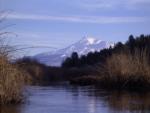Choose a project to get more information and links to publications.
Modeling Tool to Assess and Mitigate the Effects of Small Hydropower on Stream Fishes in a Changing California Climate
-
California’s 2005 Energy Policy Act (EPAct) provides incentives for new hydropower development that could be used to encourage development of additional hydropower capacity in California. Meanwhile, California’s mandate to increase the contribution of renewable energy sources and reduce greenhouse gas emissions has led to incentives to increase the production of energy from small hydropower as part of California’s Renewable Portfolio Standard. However, this may come with costs to native fish species.
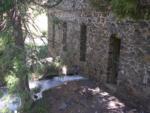
Temperature Preference and Tolerance of Hardhead Minnows
-
California’s populations of hardhead minnow (Mylopharodon conocephalus), a fish species of special concern, have experienced population declines, possibly due to habitat perturbations, including dam construction with consequent temperature changes and the introduction of non-native species to California’s mid- to low-elevation streams. Environmental temperature effects on this large (up to 60 cm (2 ft) Standard Length) native species are poorly documented.
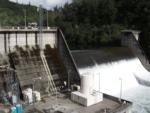
Climate Change and Spring-Run Chinook Salmon
-
Spring-run Chinook salmon (Oncorhynchus tshawytscha) are vulnerable to climate change because adults over-summer in freshwater streams before spawning in autumn. In California’s Central Valley their distribution is limited to three watersheds with small numbers appearing intermittently in seven other watersheds where access to coldwater pools remains unobstructed. Annual spring-run Chinook salmon runs used to number approximately 1 million fish, but they have declined to approximately 16,000 in the Central Valley.
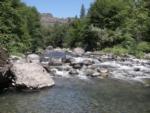
Hydropower-related pulsed-flow impacts on stream fishes
-
The societal benefits of hydropower systems (e.g., relatively clean electrical power, water supply, flood control, and recreation) come with a cost to native stream fishes. Until now, the specific effects of the associated pulsed-flow releases on stream fishes have not been reviewed in detail, or synthesized in a conceptual model that would allow managers to predict and mitigate the negative effects.
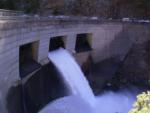
Steelhead Distribution and Habitat Use in the Salinas River Watershed
-
The Salinas River and its tributaries have been designated by the National Marine Fisheries Service as critical habitat for steelhead (Oncorhynchus mykiss), listed as “threatened” under the Federal Endangered Species Act. The watershed is part of the South-Central California Coast Evolutionarily Significant Unit (ESU) for steelhead. Large wood is known to be very important to fish habitat in conifer-dominated streams of the Pacific Northwest, but has not been well studied in hardwood-dominated streams of the central California coast.
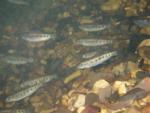
Effects of Pulsed Flows from Dams on Fishes: Field and Lab Studies
-
Pulsed flows in rivers are relatively rapid increases in flows followed by relatively rapid decreases, with flow fluctuations lasting minutes, hours, or days. Reasons for pulsed flows include: generating electricity, flushing streambeds, facilitating human recreation, providing additional water for downstream diversion for irrigation, and preventing reservoirs from flooding. Although pulsed water releases provide obvious benefits to humans, the cumulative effects of repeated and unseasonal flow pulses on aquatic communities are relatively unknown.
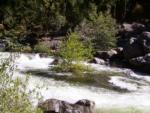
Restoration of Wild Eagle Lake Rainbow Trout
-
Pine Creek historically provided critical spawning and rearing habitat for Eagle Lake rainbow trout. Over the past 100+ years modifications of Pine Creek watershed decoupled the trout from its stream habitat. After 20+ years of restoration efforts in the Pine Creek watershed, a key question is, are rainbow trout able to migrate to the headwaters of Pine Creek?
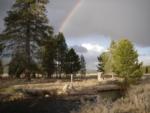
Management of Leonard Lake
-
Leonard Lake is the largest natural lake in Mendocino County, and is located approximately 140 miles north of San Francisco, California. The managers of the lake are interested in the current state of the lake, and in managing it sustainably for future generations.
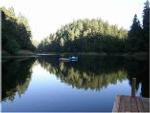
Rainbow Trout Distribution and Habitat Use in Rangeland Streams
-
Many California rangeland watersheds experience extensive livestock use, and many landowners divert stream water for pasture irrigation. Fish population declines and habitat alteration across northern California watersheds have resulted in the listing of species under the Endangered Species Act, and the implementation of water quality strategies for impaired waterbodies. These events highlight the importance of species recovery and habitat restoration efforts, and bring the potential impacts of agricultural practices under increasing scrutiny.
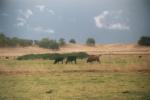
Conservation of Shasta River Coho Salmon
-
Coho salmon (Oncorhynchus kisutch) in the Shasta River are part of the federal Southern Oregon/Northern California evolutionary significant unit (SONC ESU) and are listed as threatened. At the state level coho salmon in the Shasta River are part of the Northern California designation, and are also listed as threatened. There are multiple factors that may limit salmonid populations in the watershed, including water quantity, water quality, riparian dysfunction, excessive sediment yield, spawning requirements, and rearing requirements.
